How to cook the perfect mulligatawny
It's a relic of the Raj and sits ignored on many Indian restaurant menus, yet the soup is one of the great gastronomic hybrids. So what's the best way to get east to meet west?
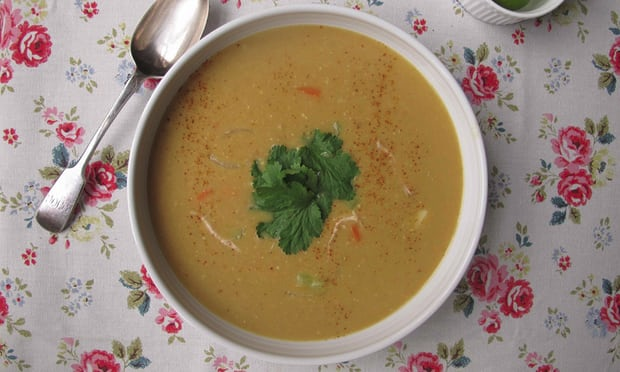
Currying favour: a proper mulligatawny can be a meal in itself. Photograph: Felicity Cloake for the Guardian
Mulligatawny is a cornerstone of the classic British Indian restaurant repertoire, always there, yet never ordered. Like kedgeree and mango chutney, it is part of the culinary legacy of the Raj – an Indian dish adapted to suit colonial tastes, in this case a thin, spicy Madrassi broth known as molo tunny, or "pepper water", intended to be served with rice. Unfamiliar with this soup thing their masters seemed to require with every meal, Indian cooks served the nearest thing to it that they knew, bulking it out with meat and vegetables to suit the extravagant tastes of the British.
According to Lizzie Collingham's excellent Curry: A Tale of Cooks and Conquerors, "mulligatawny soup was one of the earliest dishes to emerge from the new hybrid cuisine which the British developed in India, combining British concepts of how food should be presented … and Indian recipes". Madhur Jaffrey describes it as "a classic of the mixed-race, Anglo-Indian community in India" and "an essential part of my childhood", while Colonel Arthur Robert Kenney-Herbert, author of the 1878 recipe collection, Culinary Jottings for Madras, recommends it as a "really excellent, and at times, most invigorating soup". Mulligatawny doesn't deserve to be hidden away at the top of the menu, outshone by samosas and seekh kebabs. Made with care, this unapologetically old-fashioned, gently spiced fusion classic is, as Jaffrey puts it, "really a curry, a meal in itself".
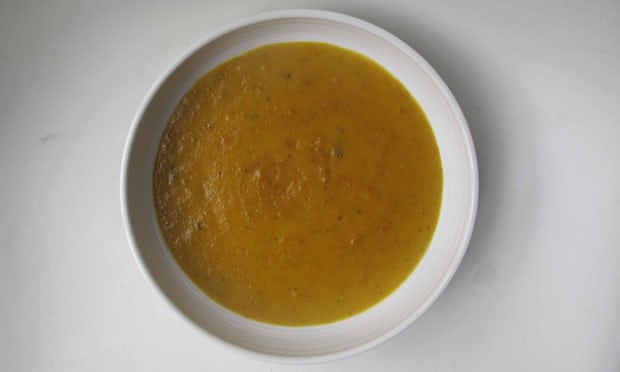
Historically accurate: Wyvern's 'mulligatunny' recipe dates from 1878. Photograph: Felicity Cloake for the Guardian
The meat
Kenney-Herbert, who wrote under the pen name Wyvern, notes that "a very excellent muligatunny [sic] can be made without any assistance from flesh or fowl", but that generally, as Jaffrey puts it in her Ultimate Curry Bible, "even though there are some recipes for vegetarian mulligatawny in old cookbooks, most often they are made with mutton or poultry". Rick Stein uses a tiny amount of chicken thigh in the version in his book India: In search of the perfect curry and Jaffrey suggests either chicken or boneless lamb, while Atul Kochhar adds meat in the form of a lamb stock in the recipe collected in Paul Gayler's Great Homemade Soups, and Julie Sahni's mulligatawny in Lindsey Bareham's A Celebration of Soup deploys rich chicken stock.
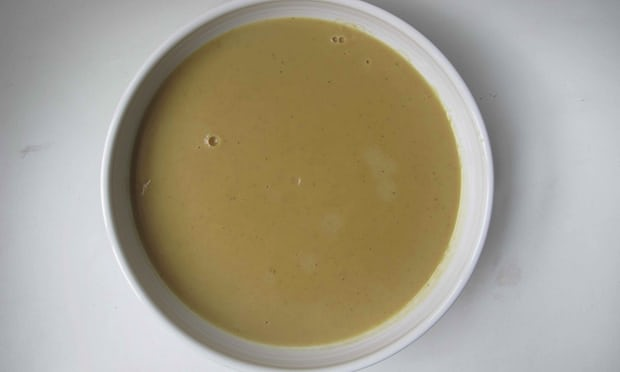
Atul Kocchar uses lamb stock for his mulligatawny, but it may be too meaty for some. Photograph: Felicity Cloake for the Guardian
From the seven pages given over to the subject by Wyvern, it seems that, traditionally, mulligatawny would have contained "the choicest pieces" of the meat used to make the stock base, and indeed, chicken in particular works well (the breast or neck of mutton or lamb he also suggests take rather longer to cook). Experiments with his vegetarian recipe prove interesting both in terms of flavour and the method he suggests of preparing the consommé base. After frying carrots, onions and celery in a good deal of butter, they are boiled with pepper and peas for three hours to produce a thick mush which proves a robustly flavoured base for his soup. Vegetarians might be interested to try it as an alternative to a more modern vegetable stock.
While preparing a chicken stock from scratch seems likely to discourage most from making this particular soup, said stock does make for a more richly flavoured base than plain water – Kochhar's lamb does not prove popular ("too lamby" apparently). Substitute a good vegetable alternative if you'd prefer.
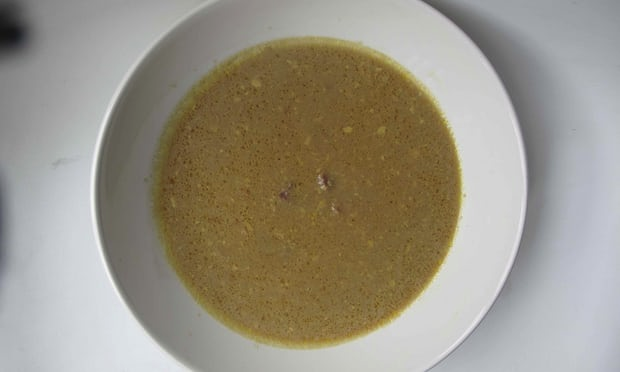
Madhur Jaffrey's mulligatawny eschews vegetables. Photograph: Felicity Cloake for the Guardian
The vegetables
Jaffrey eschews vegetables, but most recipes start with the traditional European trinity of onion, carrot and celery, with Sahni also adding parsnips and mushrooms, and Stein going for leeks and tomatoes. Though not traditional Indian vegetables, the parsnips and leeks give the soups they grace a pleasant sweetness which means I will need to add less sugary chutney, which can only be a good thing. If you can't get hold of them, substitute more carrot, or indeed any similar sweet root vegetable instead. Kochhar also throws in granny smith apples for sharpness, but lemon juice seems a simpler option.
Only Stein's soup contains whole pieces of vegetable in the finished dish, but having already decided to have a little meat in there, I would like to retain a few chunks for balance.
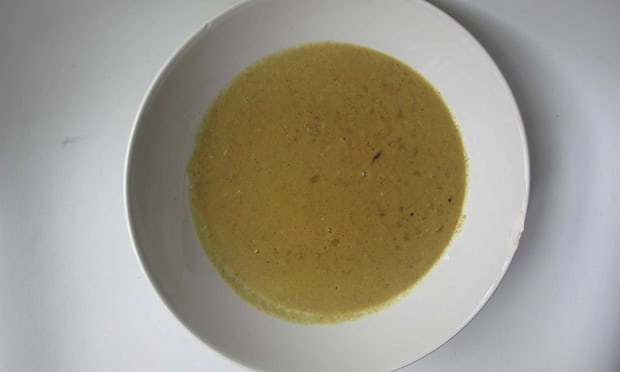
Julie Sahni keeps the spicing basic. Photograph: Felicity Cloake for the Guardian
Herbs and spices
Most recipes I try, with the exception of Wyvern's (no garlic please, we're British), are flavoured with root ginger and garlic, both of which seem like a must for a well-rounded soup. Sahni and Stein add fresh coriander, which I would prefer to save for the garnish, and Stein mint and, like Kochhar, curry leaves, which are annoyingly hard to get hold of in Britain (and, no doubt, would have been even harder in mulligatawny's heyday).
My feeling, however, is that this should be a fairly simple recipe, in obedience to its origins; Wyvern calls only for "mulligatunny paste" or curry powder ("Barrie's 'Madras' if possible" – it's not these days, sadly), and Sahni keeps the spicing similarly basic, adding just black pepper, while Kochhar favours dried red chillies. Jaffrey and Stein employ more complex mixtures, with the latter making a paste from bay leaves, cloves, cinnamon, turmeric, coriander, black pepper and cumin, but I am going to stick with Madras curry powder, which already contains a fair number of those spices, plus some cayenne to add a little heat to proceedings.
Sweet and sour
Wyvern is very keen on the importance of a "pleasant sub-acid" to a mulligatawny, by which he seems to mean a combination of mango chutney, redcurrant jelly and lime juice, and Jaffrey and Kochhar both add lemon juice – whether or not you feel that your soup would benefit from a little more sweetness in the form of chutney, a touch of acidity is rarely unwelcome.

Rick Stein uses flour to thicken his soup, but others use masoor dal. Photograph: Felicity Cloake for the Guardian
The thickener
Wyvern, Stein and Sahni all thicken their soups with flour, Jaffrey whisks in a mixture of ground almonds and chickpea flour, and Kochhar uses masoor dal, which gives his mulligatawny a heartiness the others lack, though I'm not going to bother sieving it, as my testers prefer a more rustic consistency.
Finishing touches
Almond milk may seem like a very 21st-century phenomenon, but Wyvern believes a homemade version, produced by soaking flaked almonds in milk and then pounding them until smooth, is vital to a good mulligatawny, though he concedes "cocoanut milk" may be substituted. Kochhar and Stein both prefer the latter, and Sahni rounds things off with double cream, which, like Wyvern's optional egg yolks, is pronounced too rich by the testers. My testers come down in favour of the more subtle sweetness of the almonds, but feel free to use the same amount of coconut milk if you'd prefer.
Serve with flatbreads, or rice, and a heap of coriander to brighten things up – like most of the most delicious foods, mulligatawny is unapologetically brown.
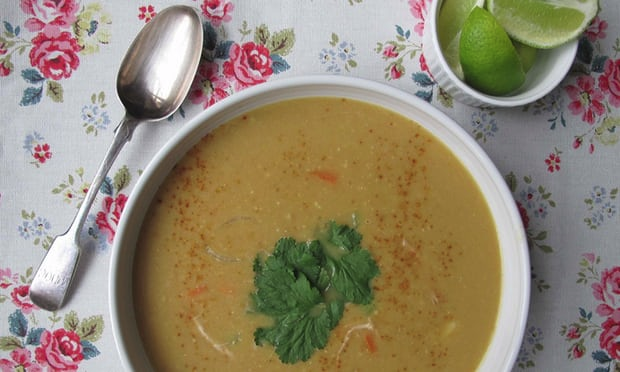
Felicity Cloake's perfect mulligatawny – with corriander and a citrus twist. Photograph: Felicity Cloake for the Guardian
- (Serves 4-6)
- 2 tbsp ghee or coconut oil
- 1 onion, finely sliced
- 1 carrot, diced
- 1 parsnip, diced
- 1 celery stick, diced
- 4 garlic cloves, crushed
- 2 tbsp finely grated fresh ginger
- 2½ tsp Madras curry powder
- ½ tsp cayenne pepper
- 1.5l good-quality chicken stock (or vegetable if preferred)
- 1 boneless, skinless chicken thigh (optional)
- 150g masoor dal (split orange lentils)
- 4 tbsp flaked almonds
- 100ml hot milk or water
- 1 tbsp lemon juice
- 1-2 tbsp mango chutney (optional)
- Small bunch of coriander, roughly chopped, to serve
Heat the fat in a medium saucepan over a medium heat and add the onion. Cook for about five minutes until soft and golden, then add the carrot, parsnip and celery and cook for another five minutes then scoop out a spoonful and set aside.
Add the garlic and ginger and cook for a minute or so, then add the curry powder and cayenne pepper and stir for a minute. Pour in the stock, add the chicken and dal, bring to the boil, then turn down the heat, cover and simmer for 35 minutes. Meanwhile, soak the almonds in the hot milk or water.
Remove the chicken from the pan. Blitz the soup with a hand blender until smooth, then whizz the almonds to a puree and whisk them into the soup. Add lemon juice and salt to taste, then stir in the chutney to taste if you would prefer it sweeter. Pull apart the chicken into strands and stir into the soup along with the reserved vegetables.Divide between bowls and garnish with coriander.
Mulligatawny: a recipe that deserves relegating along with the Raj, or one of the few good things to have come out of Britain's colonial past? Are you one of the few people keeping it on Indian restaurant menus – and which other Anglo-Indian favourites would you recommend to other readers?